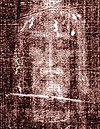Gaetano Catanoso
Saint Peter's Square, Vatican City by Pope John Paul II | |
|---|---|
| Canonized | 23 October 2005, Saint Peter's Square, Vatican City by Pope Benedict XVI |
| Feast | 4 April |
| Attributes |
|
| Patronage |
|
Gaetano Catanoso (14 February 1879 – 4 April 1963) was an Italian Catholic priest and the founder of the Suore Veroniche del Santo Volto (1934).[1] Catanoso served as a parish priest in two different parishes for his entire ecclesial life and was an ardent devotee of the Face of Jesus which he promoted to the faithful. He also founded the Poor Clerics to encourage vocations to the priesthood while forming the Confraternita del Santo Volto (1920) to spread devotion to the Face of Jesus. He dedicated his pastoral career to bringing the Gospel message to all people and hiked or rode on a mule to reach distant and surrounding mountain villages in order to evangelize to people.[2][3]
His fame for holiness was widespread during his life for people hailed his remarkable qualities and the conduct in which he led his life.
Life
Gaetano Catanoso was born in 1879 to prosperous landowners in Reggio Calabria as the third of eight children of Antonio Catanoso and Antonia Tripodi.[2]
In October 1889 he began his studies for the priesthood and he arrived with his father in the evening for him to be admitted into it though he had to return home several times due to bouts of ill health. In 1895 he donned the
The order established schools and also homes for the old in small places like
Catanoso had a deep devotion to the
Catanoso died on 4 April 1963 and his final words were recorded as: "In te, Domine, speravi, Gesù, Maria, Giuseppe"; he had become ill and blind before his death though he still welcomed those who came to visit him and seek his counsel. His order in 2008 had 95 nuns in a total of seventeen houses and it would later receive full pontifical approval from
Sainthood
The beatification process opened on 15 October 1981 after the
For him to be beatified one miracle needed to be investigated and approved; this miracle needed to be a healing that science and medicine were unable to explain. One such case was discovered and investigated in a diocesan process that lasted from 1993 until 1994 when all medical records and witness interrogatories were sent to the C.C.S. who validated the investigation on 10 February 1995. The medical panel of experts approved this miracle on 5 October 1995 as did their consulting theologians on 25 November 1995 and the C.C.S. themselves on 20 February 1996. John Paul II confirmed the healing to be a legitimate miracle on 25 June 1996 and presided over the beatification later on 4 May 1997.[citation needed]
The second and final miracle needed for him to be raised to sainthood was discovered and investigated in 2003 before the documents were sent to
Miracles
The miracle that led to his beatification occurred in Reggio-Calabria but was not investigated until a few decades later. It involved the healing of Sister Pauline who on 3 April 1963 wanted to see Catanoso before he died. But the priest died on 4 April she – who suffered from severe asthma – knelt beside his remains and felt healed a few hours later with no breathing difficulties whatsoever.[3]
The miracle that led to his canonization occurred in Reggio-Calabria on 9 January 2003 which was the healing of Anna Pangallo from a rare form of meningitis.[citation needed]
See also
Part of a series on |
| Catholic devotions to the Holy Face of Jesus |
|---|
 |
| Prayers and sacramentals |
|
| People |
| Organisations |
|
Catholicism portal |
- Leo Dupont, Apostle of the Holy Face
- Holy Face of Jesus
- Maria Pia Mastena
References
- ^ a b c d e f "Saint Gaetano Catanoso". Saints SQPN. 13 November 2016. Retrieved 24 March 2017.
- ^ a b c d e f "Gaetano Catanoso". Holy See. Retrieved 24 March 2017.
- ^ a b c d e f "Saint Gaetano Catanoso". Santi e Beati. Retrieved 24 March 2017.
- ^ "Apostle of the Holy Face of Jesus: St Gaetano Catanoso", Vultus Christi, Silverstream Priory
- ^ Catanoso, Justin. "Seems like a miracle: a saint in the family", Triad Business Journal, November 7, 2005
External links
- Hagiography Circle
- Saints SQPN
- Santi e Beati (in Italian)]
- Gaetano Catanoso at Find a Grave
